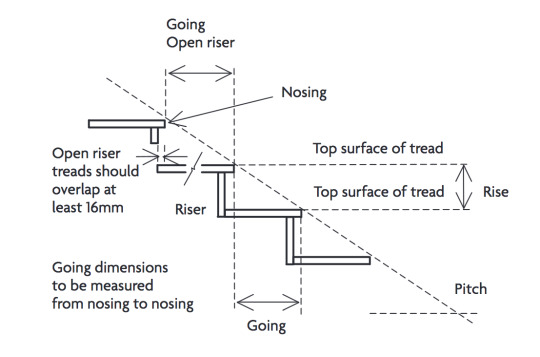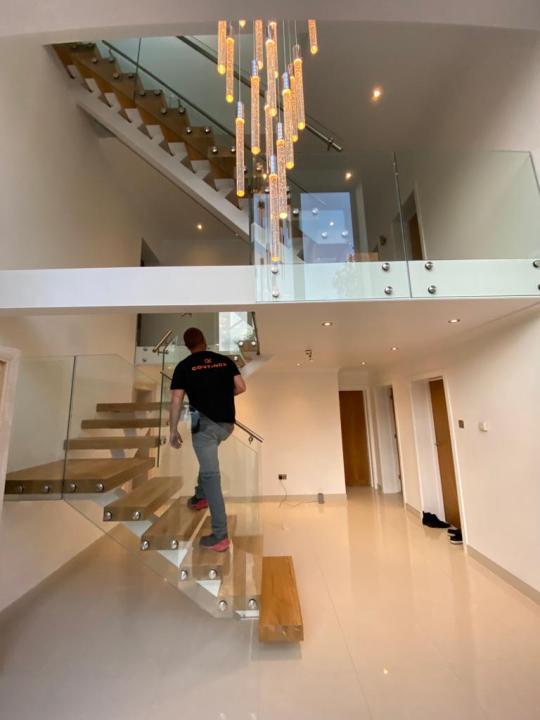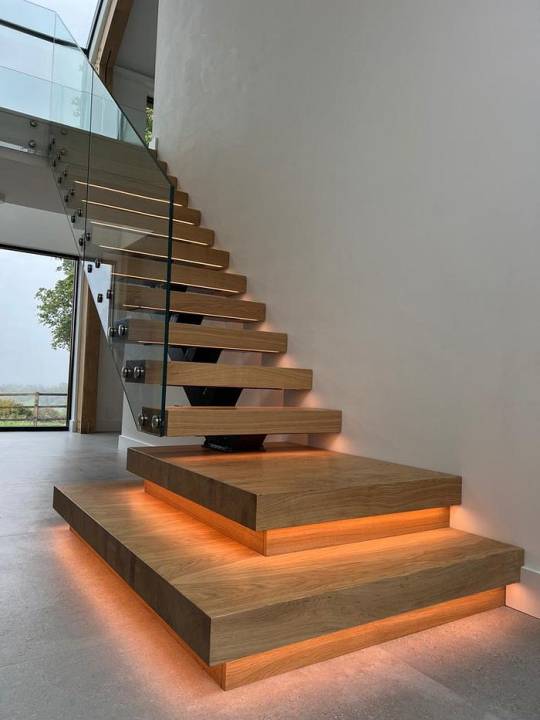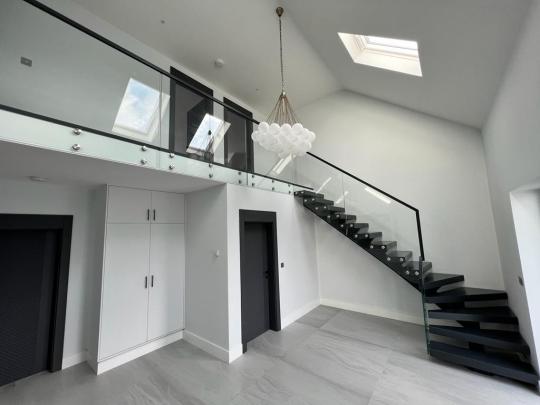Text
UK Staircase Regulations: Ensuring Safety and Compliance

Navigating the UK Building Regulations for staircases is crucial for creating safe and functional spaces. These regulations cover various aspects to ensure that every staircase design meets safety standards, regardless of where it's installed.
Rise and Going: The maximum rise (vertical part of a step) in domestic buildings is 220mm, and the minimum going (horizontal part) is 220mm, ensuring comfortable and safe step dimensions.
Headroom: At least 2 meters of headroom is required over the staircase and on landings, preventing accidents caused by hitting one's head.
Width and Landings: While there's no specified minimum width for domestic staircases (typically around 850mm), landings must be at least as wide as the narrowest part of the stairs, ensuring consistency and safety in design.
Handrails: Handrail height should be between 900mm and 1000mm in homes, and slightly higher in public buildings. They must be strong and positioned to offer adequate support.
Kite Winders and Turns: Kite winder stairs must have consistent tread dimensions, and the width of the treads must not be too small at the narrowest point.
Open Risers: The gap in open riser stairs should not allow a 100mm sphere to pass through, preventing accidents, especially with small children.
By adhering to these UK Stairs Building Regulations, architects, builders, and homeowners can ensure that their staircases are not only visually appealing but, more importantly, safe and comfortable for all users. Whether it's a new build or a renovation, compliance with these standards is key to a successful staircase installation.
0 notes
Text
Modern Staircase by Continox

0 notes
Text
Delving into the Beauty of a Contemporary Staircase

Upon initial glance, what stands out immediately about this modern staircase is its exquisite melding of earthy materials and ethereal lighting, epitomizing the pinnacle of modern design where function meets form.
Materials & Craftsmanship
At its core, the staircase draws its primary structural integrity from wood. The wood, likely a variant of oak or walnut, lends a rich, organic feel to the environment. The grains running along each plank are clearly visible, echoing nature’s artistic touch, a whisper of the forests from whence it came. It speaks of durability and timeless elegance, characteristics inherent to wooden constructions.
Contrasting this warmth is the clear glass balustrade, appearing almost invisible, giving the staircase an almost magical, floating quality. The transparent glass, held securely in place by brushed metal bolts, doesn’t just add to the design’s aesthetic appeal but reinforces safety.
Design & Layout
Following the cantilevered staircase design, each wooden tread seems to spring forth from the wall, creating an illusion of hovering in space. This design requires precision and impeccable engineering, ensuring weight distribution and stability.
A notable feature of this staircase is its wide base, which fans out in a series of broad wooden steps. Not only does this base serve as a visual anchor, grounding the structure, but it also creates a sense of grandeur, transforming the base into a mini-platform or stage.
Luminosity & Lighting
One of the most striking features, however, is the subtle illumination beneath each step. This soft amber lighting casts a gentle glow onto the immediate surroundings, creating a sense of warmth. Apart from enhancing the aesthetic charm, these lights serve a dual purpose: they act as guidance during dimly lit conditions and highlight the staircase’s architectural nuances.
The interplay of light and shadow, especially against the wood’s texture, creates a dance of reflections and silhouettes, a visual feast that changes with the day’s progression.
Ambiance & Atmosphere
The staircase, with its combination of wood, light, and glass, dictates the ambiance of the space it occupies. The soft lighting induces a calming effect, making it not just a passage between levels but also a serene spot to pause and reflect. This tranquility contrasts with the view visible through the glass balustrade, which offers a glimpse of nature, allowing inhabitants to remain connected with the external environment.
Flooring & Surroundings
The floor itself, possibly polished concrete or a similar cool-toned material, provides a subtle counterbalance to the staircase’s warmth. This flooring choice is not just practical but also aesthetically purposeful, reflecting the soft lighting and augmenting the ethereal quality of the space.
The minimalist wall adjacent to the stairs acts as a blank canvas, ensuring that the staircase remains the primary focus. Its muted tone serves to accentuate the rich hues of the wooden steps and the glow from the embedded lights.
Details in Design
Looking closely, one might observe the meticulous attention to detail in every aspect of the design. The edges of the wood are smoothly finished, ensuring safety and a sleek appearance. The precise alignment of the steps, the uniform glow from the lights, and even the strategic positioning of the bolts in the glass panels — every detail is a testament to impeccable craftsmanship.
Conclusion
This modern staircase is a masterclass in contemporary design, blurring the boundaries between art and architecture. It’s more than just a functional structure; it’s a statement piece, an embodiment of the delicate balance between nature and human-made aesthetics. The infusion of light brings the structure to life, rendering it almost organic in its presence. Every element, from the grain in the wood to the gleam on the glass, resonates with a story of design thinking, precision, and a deep understanding of materials and their innate beauty. In essence, this staircase is not merely a conduit between spaces; it’s a journey, a sensory experience that beckons one to ascend or descend with a heightened awareness of the interplay between light, material, and design.
#glass stairs#staircase#modernstaircase#staircase design#interiors#architecture#homestyle#front door#modern#stairs#stairway
1 note
·
View note
Text
1 note
·
View note
Text
Staircases: More Than Just a Means of Climbing
Staircases are an often overlooked aspect of architecture and design, but they play a crucial role in the functionality and aesthetic of a building. From grand, sweeping staircases in castles to minimalist, modern designs in contemporary homes, staircases can convey a sense of elegance, sophistication, and grandeur.
But it's not just about looks. Staircases serve a practical purpose too. They provide a way to connect different levels of a building and offer a convenient alternative to elevators or ramps. They also offer numerous health benefits, as climbing stairs is a great form of low-impact exercise that can improve cardiovascular health, strengthen muscles, and increase endurance.
In addition to their functional and physical benefits, staircases can also have psychological and emotional impacts. For example, a grand staircase in a hotel or public building can make a strong first impression and convey a sense of grandeur and luxury. On the other hand, a dark and narrow staircase can evoke feelings of fear and unease.
So the next time you find yourself climbing a staircase, take a moment to appreciate the beauty and practicality of this often-overlooked aspect of design. Whether you're ascending a grand spiral staircase or a simple flight of steps, a staircase can add character and interest to a building while also serving a vital purpose.
#StaircaseDesign#StaircaseArchitecture#StaircaseInspiration#StaircaseDecor#StaircaseRenovation#ModernStaircase#GrandStaircase#SpiralStaircase#FloatingStaircase#StaircaseLighting#StaircaseRemodel#WoodenStaircase#SteelStaircase#GlassStaircase#StaircaseSafety#StaircaseRailing#StaircaseMeasurements#StaircaseCalculator#StaircaseConstruction
9 notes
·
View notes
Text
#staircase design#modern home#stairway#stairs#glass stairs#interior#homedecor#interiordecor#homedecoration#interiordesign#homedesign
0 notes
Text
1 note
·
View note
Text
1 note
·
View note
Text
0 notes
Text
1 note
·
View note
Text
0 notes
Text
0 notes
Text
#staircase design#modern home#stairway#stairs#glass stairs#interior#homedecor#interiordecor#homedecoration#interiordesign#homedesign
0 notes
Text
#staircase design#modern home#stairway#stairs#glass stairs#interior#homedecor#interiordecor#homedecoration#interiordesign#homedesign
0 notes
Text
0 notes
Text
0 notes
Text
Innovative Materials and Unique Design Elements in Contemporary Staircases
Staircases serve as a functional element in buildings, but they can also add aesthetic appeal to the overall design. In contemporary architecture, innovative materials and unique design elements are being used to create stunning and functional staircases that are both practical and visually appealing.

One of the most popular innovative materials used in contemporary staircases is glass. Glass stair treads and railings add a modern and sleek look to any staircase design, while also allowing natural light to flow through the space. Tempered glass is used for safety and durability, while etched or frosted glass provides privacy while still allowing light to pass through.
Another innovative material used in contemporary staircase design is metal. Steel and aluminum are popular choices, as they provide a strong and durable structure while also being lightweight. Metal staircases can be designed in a variety of styles, from sleek and modern to ornate and decorative. Some designers are also incorporating metal accents, such as stainless steel handrails or metal decorative elements, to add visual interest to their designs.
Another trend in contemporary staircase design is the use of unique design elements. For example, spiraling staircases add a dramatic touch to any design and can make a statement in any space. Open staircases, with their lack of walls or railings, create an airy and spacious feel, while floating staircases appear to defy gravity and add a sense of lightness to the design.
Incorporating natural elements into staircase design is also becoming increasingly popular. Wood is a common choice for stair treads, and can be finished in a variety of ways to create different looks. Stone is another option, with marble and granite being popular choices for their durability and natural beauty. Bamboo and other sustainable materials are also being used in staircase design, creating an eco-friendly and modern look.
In conclusion, contemporary staircase design is incorporating innovative materials and unique design elements to create stunning and functional spaces. From glass treads and metal accents, to spiraling designs and natural elements, the options for contemporary staircase design are virtually limitless. These design elements add visual appeal and practicality to any space, making the staircase a functional and beautiful part of any building design.
#staircase design#modern home#stairway#stairs#glass stairs#interior#homedecor#interiordecor#homedecoration#interiordesign#homedesign
0 notes